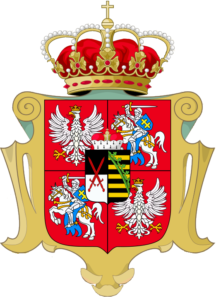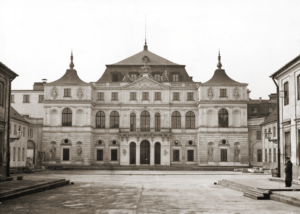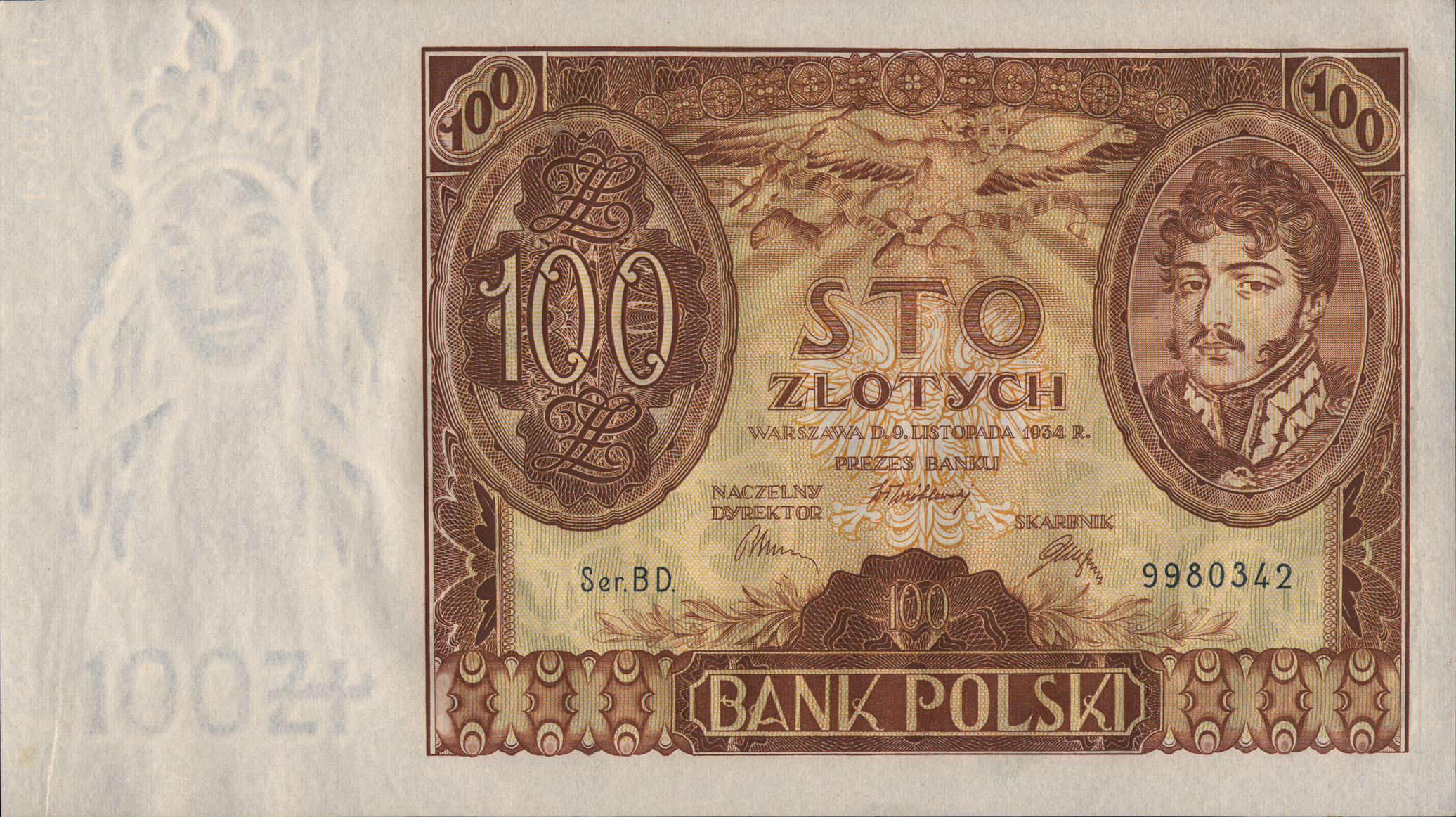The question posed in the title is provocative, but it also refers to a special episode in history. Two states, the Polish-Lithuanian Commonwealth and the Electorate of Saxony, whose history, traditions, political systems, and social relations had been different until 1697, and which did not even share a common border, became united in a personal union by the election of Frederick August I, Prince of Saxony of the Albertine Wettin line, as King of Poland (as August II Wettin).
by Adam Perłakowski
Historians generally agree that the aim of this union was to bring about a much more far-reaching unification of Poland and Saxony. What was its nature? One can say without a shadow of a doubt that the plan of the first of the Wettin dynasty was to unite the elites of the Commonwealth and Saxony through family ties, which was to be aided by a matrimonial policy that was sensible from the ruler’s point of view. Mixed Polish-Saxon marriages were to become the basis for the creation of a new power elite, and this in turn, in the monarch’s intention, could make it much easier to bring about a real Polish-Saxon union.

Who liked Wettin?
These plans remained unrealised, and both the population living in the multi-ethnic Commonwealth, and the inhabitants of Saxony, had their share in this. This is an important observation, as it deconstructs the historians’ ideas about the great opportunities the union offered this part of the continent. If one takes a look at the output of Polish, German (especially Prussian, at the turn of the 19th and 20th centuries), Russian, or even Swedish historiography, we can find various interpretations of the significance of the Polish-Saxon Union for the states and societies of Central and Eastern Europe.
These reflections have taken on different shades, most often of acrimonious criticism, especially by Prussian historians condemning the involvement of Saxony and its rulers in the union with the Polish-Lithuanian Commonwealth. It is interesting that Polish historiography of the inter- and post-war period also referred to this perception of the would-be union. For Germans (Prussians), the union marked the beginning of the decline of the Electorate of Saxony in the national German arena, its economic and political collapse, which finally took place during the Seven Years’ War (1756–1763). It was also believed that it was Saxony that financed Poland, and thus itself fell into deep economic crisis. However, historians forget that the decline of Saxony was largely due to the policy of the Kingdom of Prussia, which, especially since the accession of Frederick II Hohenzollern to the throne, pursued an expansionist policy aimed at subjugating Saxony, or at least weakening its international importance.

Saxon misfortunes
Polish historians have made otherwise correct accusations, claiming that the irresponsible policy of August II brought many misfortunes upon the Polish-Lithuanian Commonwealth, including participation (passively and, from 1704, actively) in the Great Northern War (1700–1721), with disastrous consequences: the destruction of the country and the impoverishment of its population, the decline of the political significance of the Commonwealth, and the creation of opportunities for neighbouring states (Russia and Prussia) to interfere in the internal affairs of the Polish-Lithuanian state. This interference, which increased throughout the 18th century, eventually led to the collapse of the Commonwealth, sadly culminating in the partitions of Poland (in 1772, 1793 and 1795), which did not take place under the rule of the Wettins.
This picture began to change gradually in the 1960s and 1970s. Historical research using Dresden sources led to somewhat different, more ambiguous conclusions and judgements about the Polish-Saxon Union, with credit due to such scholars as Józef Andrzej Gierowski of Krakow and Jacek Staszewski of Toruń. They showed new possibilities for research on the Saxon era (especially from the Polish perspective), and consequently for the new assessment of its impact on the history of the Commonwealth. However, it is not easy to find a balance in historiography: after 1989, some Polish historians (and German ones, to a lesser extent) tended to ‘mythologise’ this epoch and its rulers, of which the figure of August III Wettin is a perfect example.
The hitherto image of the second of the Wettin kings on the Polish throne as fat, lazy, lacking in political ambition, indulging in primitive entertainment, and leading Saxony and Poland to their inevitable downfall, was replaced by the image of an active, extremely hard-working ruler, an outstanding patron of culture (especially in Poland), and even a man well versed in the meanders of power. This is exemplified by the peculiar division of competences in the area of governance in the Commonwealth, and the introduction of a system of so-called ministerial rule, exercised by the first Minister, Heinrich von Brühl.Meanwhile, the problem of interpreting the actions and, above all, the motivations behind specific decisions taken by monarchs from the Saxon dynasty defies clear-cut assessment. The Saxon era, with its various ‘shades’ and the need to deconstruct existing stereotypes and myths – those showing only negative sides, as well as those leaning towards excessive optimism – undoubtedly requires further research.

Could the election of August II, his rule (1697–1733), and then the reign of August III (1734–1763) have radically changed the situation on the geopolitical map of this part of Europe in the early 18th century and the first half of the century? Let us put aside the ‘fairy tales’ about the great potential of Saxony ruled by the Wettin family, which had enjoyed peace since 1635, and which could have resulted in the union with the Polish-Lithuanian Commonwealth creating a power of, if not European, then at least regional significance, which would have successfully held off the temptations of its neighbours (Prussia, Russia and, to some extent, Austria).
The discreet charm of Dresden
Saxony was not a militarily strong state, which was quickly demonstrated by the defeats suffered by the army of August II during the Great Northern War, resulting in the Swedish occupation of the Electorate in the years 1706–1707. The final blow to Saxony’s armed forces came several decades later when, during the Seven Years’ War, the Saxon army was forced by Frederick II to shamefully surrender at Pirna on 14 October 1756, as a result of which the Electorate’s army de facto ceased to exist.
The Polish-Lithuanian Commonwealth was also experiencing a political and economic crisis at that time. However, what most determined the mutual relations of the two states, and had a decisive impact on the further fate of Poland and Saxony, was the almost complete indifference of the citizens of these states to the union itself and the political concepts associated with it (a closer union or even a real union), pushed especially by August II. To put it bluntly: the union was accepted, if necessary mainly in ideological terms, but no attempts were made to transform it into a different (more real) political arrangement.
Contacts between the Polish and Saxon elites were dominated by curiosity, typical for someone with a vague idea of an unknown neighbour, but also by great reserve and even dislike. This model of mutual perception did not change throughout the entire 66 years.

From the perspective of a historian (researcher) dealing with the period of the Polish-Saxon union, it can be assumed that this model of coexistence and cooperation between the two states was doomed to failure. Of course, contemporaries could not know that. The initial three years offered some hope of overcoming the crisis in which the Commonwealth had found itself for several decades. In 1699, a peace treaty with Turkey was signed at Karlowitz, under which the Commonwealth regained Podolia, including the strategically important fortress at Kamianets-Podilskyi, and part of the Bratslav Voivodeship, lost back in 1672. This undoubtedly marked a major diplomatic success for August II, whose popularity with the nobility-dominated society grew decidedly. Unfortunately, his subsequent foreign policy and diplomatic moves were marked by a string of disastrous choices and failures. The entanglement of the Commonwealth and Saxony in the war with the Swedish King Charles XII of Wittelsbach (the Great Northern War), military defeats, the economic ruin of the Polish-Lithuanian state, and the crisis between the monarch and his subjects, resulted in increasing interference by neighbouring states (above all Russia) in the internal affairs of the Commonwealth. This also undermined the credibility of August II on the international arena, leading to his isolation. In the 1720s and 1730s, Prussia started to increasingly boldly put forward its ideas for partitioning parts of the Polish territories, and was for the time being restrained by Russia, which wanted to turn Poland into an exclusive zone of its influence.
Meanwhile, the foreign policy moves of the first of the Wettins on the Polish throne were mostly chaotic, not taking into account the current circumstances, although sometimes the monarch was able to rationally assess the situation and accurately diagnose the dangers threatening the state. Unfortunately, his ambitions to make Poland a ‘prosperous country that enjoys the respect of its neighbours’ (this is a reference to a political treatise likely drafted by August II at the beginning of his reign) amounted to nothing. The almost permanent conflict with the nobility over plans to strengthen the King’s power, or to conduct politics without regard for the most important element of power in Poland, i.e. the Sejm, resulted in the nobility’s almost universal dislike of the King’s policy. Although the 1717 reform of the state was successful to a large extent (Silent Sejm), August II devoted the 1720s exclusively to securing the Polish crown for his son, which was finally achieved by the election of 1733, during which the Saxon candidate enjoyed the military support of Russia.

Great father, lesser son
The reign of August III Wettin was entirely marked by a string of failures in foreign policy and diplomacy. There was no longer any question of ‘escaping from’ Russia’s orbit of influence. Attempts to reform the Commonwealth’s military and financial system undertaken in the 1740s (the auctioning off of the army) failed, as they ran into opposition from Russia. August III’s dreams of the imperial crown, which had accompanied him since the death of his male heir, Charles VI of Habsburg, in 1740, were supported neither by real military power nor by a sensible foreign policy. They provided evidence of the unreal world in which the Polish monarch lived. His disastrous policy had led to the tragedy of Saxony. The hereditary Wettin dominion was invaded by Prussia, occupied for several years, and forced to pay large contributions to Frederick II, who did not even shrink from paralysing Saxony’s financial system by minting worthless Saxon money. When the Peace Treaty of Hubertusburg was signed in 1763, Saxony was already a state of secondary importance in the political structure of the Holy Roman Empire of the German Nation, and its place was taken by Prussia.
The Wettins missed the opportunity offered by the Polish-Saxon union, however both for different reasons. It is impossible to deny August II his desire to act, his attempts at reform, and bringing about lasting change. The point is, however, that, more often than not, this involvement did not yield satisfactory results, political goals were poorly defined, and the monarch was unable to convince the nobility-dominated society of the Polish-Lithuanian Commonwealth of his reasons. If he tried, he did so ineptly.

His son, August III, was content almost exclusively with remaining in power for his own pleasure, which, of course, did not prevent him from having unfounded dreams of winning the imperial crown, and from having a high opinion of his own dignity, royalty, and majesty.
This was compounded by the extremely unfavourable geopolitical situation of the Polish-Lithuanian Commonwealth, which, in the first half of the 18th century, was unable to resist the influence of neighbouring states. The potential of the Polish-Saxon Union was not exploited at all. Sometimes one even gets the impression that the creators of the union (the King-elector and the political elites) committed the ‘sin of negligence’, which had very serious consequences in later years. However, the Polish-Saxon union survived very strongly in tradition and historical memory. In the 19th and 20th centuries, it was repeatedly referred to, with references to both negative and positive effects, the latter also present. However, it failed as a political project. Perhaps the brightest reminder of that time (at least for Baroque aficionados) is the idea that Johann Sebastian Bach was formally a subject of the Polish king, and Polish nobility will long fondly remember the affluence of the Saxon times, immortalised by the following saying: ‘During the reign of a Saxon king, eat, loosen your belt, and drink’.
Author: Prof. Adam Perłakowski
Translation: Alicja Rose & Jessica Sirotin





